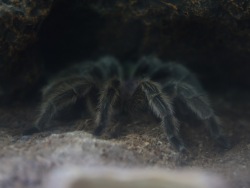New inhabitants of the Tropical Rain Forest

Several new animals have recently been added to the Tropical Rain Forest exhibit of the Primorsky Aquarium. They arrived at the Aquarium as babies and now they are grown-ups.
Chilean rose tarantula (Grammostola rosea) is one of the most common pets of tarantula hobbyists due to its distinctive coloration and docile temperament.
There are two color forms of this species, the normal rose color form and the red color one. The normal rose form has a bright pink carapace and grey hair. The red form is more like bright copper colored, which is unusual for this group of hairy spiders.
As members of the Tropical Rain Forest Department recall, they first saw their Chilean rose as a small spiderling, and now it is a beautiful adult female.
This tarantula is distributed in Bolivia, Argentina and Chile. It digs deep into the ground and spends most of its time in the burrow. However, Grammostola rosea’s behavior is different in terrarium: here, it is a typical terrestrial species sometimes creating its own hide by use of the substrate. Adult specimens have a 5–6 cm long carapace and a 15–16 cm leg span.
The two other newcomers to the Tropical Rain Forest exhibit are the representatives of the black-legged poison dart frog (Phyllobates bicolor). Phyllobates bicolor is one of the largest poison dart frogs. It ranges in color from orange to yellow, often with a blue or black tinge on their legs. Males grow to 45–50 mm of length and females can reach 50–55 mm. The species was called bicolor because of the yellow or orange body and black or dark blue lower parts of their forelimbs and hindlegs.
These poison dart frogs are found in the tropical rain forests of northwestern South America, especially in the west of Columbia. They generally inhabit the forest floor. While being mostly solitary, they may gather in large groups during the breeding season. Like all members of the family Dendrobatidae, these frogs are dedicated parents. When tadpoles hatch from the eggs, the male hoists them onto its back and they stick to the mucus on it. The father transports them to a suitable body of water, where they are fed and protected until they complete their metamorphosis.
Phyllobates bicolor is the second most toxic frog; 150 mg of its batrachotoxin-containing poison may be enough to kill an adult human due to respiratory paralysis. These frogs cannot naturally produce the toxin. Their toxins are acquired from dietary sources such as spiders, termites or other toxic organisms. Native tribes of South America used these frogs to coat the ends of hunting arrows. Interestingly, captive-born and bred dendrobatid frogs lack toxicity.
As our biologists say, this species is new for the Primorsky Aquarium. They were very small when they first arrived here and were fed with fruit flies, specific food for all poison dart frogs. Fruit flies are live food that the Aquarium breeds on its own. The two individuals of Phyllobates bicolor, supposedly a female and a male, have been raised for three years and are fully mature now.